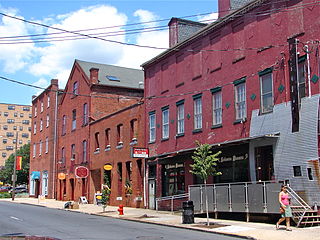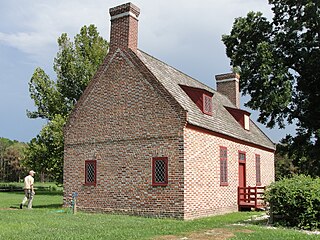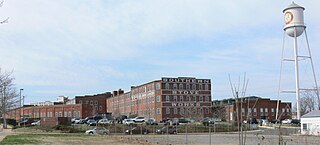
W.T. Blackwell & Co. Tobacco was a tobacco manufacturer in Durham, North Carolina. It was best known as the original producer of Bull Durham Tobacco, the first nationally marketed brand of tobacco products in the United States. The Blackwell tobacco factory in Durham, built in 1874, was declared a National Historic Landmark in 1977. It is included in the American Tobacco Company Manufacturing Plant historic district, and is now occupied by apartments.

Broad Margin is the name given to the private residence originally commissioned by Gabrielle and Charlcey Austin. It is located in Greenville, South Carolina, United States, was designed by Frank Lloyd Wright and was built by local builder Harold T. Newton in 1954. It is one of two buildings designed by Wright in South Carolina.

Liggett and Myers Tobacco Company is a historic factory building located at Huntington, Cabell County, West Virginia, USA. The original building was constructed in 1917 and is a four-story, red brick, Commercial Style warehouse building, measuring 140 by 80 feet. At the rear of the building is an addition built in 1920. It is a two-story, red brick, Commercial Style warehouse building, measuring 210 by 80 feet. Also on the property is the redrying plant, built in 1910. It is a long, one story brick industrial building with a gable roof. The complex was built by the Liggett & Myers Tobacco Company as a tobacco warehouse and cigarette factory.

Conestoga Cork Works Building, also known as E. Rosenwald & Co. Tobacco Warehouse, Rose Bros. & Co., Farmers Supply, and Rosenwald Court Apartments, is a historic factory and tobacco warehouse located at Lancaster, Lancaster County, Pennsylvania. It was built between about 1883 and 1897, and is a three-story, 31 bay brick building with a hipped and gabled roof. It has a stuccoed limestone foundation. The building was used as a cork cutting factory until 1912, a tobacco warehouse until the 1960s, then converted to apartments in 1992.

The Teller Brothers–Reed Tobacco Historic District is an historic, American cigar factory and tobacco warehouse complex and national historic district located in Lancaster, Lancaster County, Pennsylvania.

Newbold–White House is a historic house in Hertford, Perquimans County, North Carolina.

The Bright Leaf Historic District is a national historic district located at Durham, Durham County, North Carolina. It encompasses 22 contributing buildings and seven contributing structures in an industrial section of Durham. The majority of the buildings were built from the 1870s to the World War II period, and are massive two- to four-story structures, usually rectangular in form with flat or very shallow gable roofs and of fireproof construction with brick exteriors. Notable buildings include the B. L. Duke Warehouse, the Italianate style W. Duke Sons and Company Cigarette Factory (1884), Liggett and Myers Office Building, Chesterfield Building, Flowers Building (1916), Imperial Tobacco Company Factory (1916), White Warehouse (1926), and five Romanesque Revival style buildings built by The American Tobacco Company trust—Walker Warehouse (1897), Cobb Building (1898), O'Brien Building (1899), Hicks Warehouse (1903) and Toms Warehouse (1903).

The George Short House is a historic house located at 151 N. Main St. in Greenville, Kentucky. Built in the 1840s, the house is the oldest remaining home in Greenville and one of fewer than ten in the city from before the Civil War. The Greek Revival home features a two-story porch supported by columns, a transom and sidelights alongside the front door, and brick chimneys on either end of the structure.

The Martin House is a historic house located at 144 E. Main Cross St. in Greenville, Kentucky. The house was built in 1870 by the Brank family, whose 1840 house at the same site had burned down that year. The home initially had an Italianate design which featured decorative bracketing beneath its eaves. Tobacco merchant Rufus Martin bought the house in 1899, and he and his son remodeled it in the following decade. Martin's additions were mainly done in the Colonial Revival style and included a front porch supported by Tuscan columns. After Martin died in 1902, his son inherited the house; as of the 1980s, the home remained in his family.

The Greenville Commercial Historic District is a historic district located on two blocks of N. Main St. and E. Main Cross St. in Greenville, Kentucky. The district consists of thirteen commercial buildings, ten of which are contributing buildings. The buildings in the district are commercial buildings constructed in the late 19th and early 20th centuries. The oldest of the buildings are two Italianate buildings built in the 1870s. The district includes the First National Bank Building, a Beaux-Arts building constructed in 1901; a building at 121-123 N. Main with a metal facade and engaged columns; the Greenville Record building at 115 N. Main; Greenville's Odd Fellows hall at 103 E. Main Cross; and the Palace Theater at 121 N. Main.

Brooklyn Tobacco Factory, also known as the Hightower & Barksdale Tobacco Factory, is a historic tobacco factory located at Brooklyn, Halifax County, Virginia. It was built about 1855, and is a two-story, brick building with a gable roof. It features brick chimney flues projecting above the metal sheathed roof. Also on the property are two contributing pack houses and the ruins of a log house. The factory was designed and built by Dabney Cosby, Jr., son of the Jeffersonian workman, Dabney Cosby, Sr. The factory remained in operation until 1881.
Moss Tobacco Factory was a historic tobacco factory located at Clarksville, Mecklenburg County, Virginia. It was built about 1855, and was a 3 1/2-story, brick building with a gable roof erected in two sections. The Moss Tobacco Factory operated until 1862. It later housed an exchange or auction house for the sale of tobacco and as a tobacco warehouse. It was demolished in February 1980.

Southern Stove Works is a historic factory complex located in the Three Corners District of Richmond, Virginia. The complex includes four contributing red brick buildings built between 1902 and 1920. The buildings housed the foundry, assembly operations, warehouse storage, and metal storage. In 1920, Southern Stove Works vacated the buildings and moved to their new facility, Southern Stove Works, Manchester. By 1921, these buildings were occupied by the J. P. Taylor Leaf Tobacco Company.

The American Tobacco Historic District is a historic tobacco factory complex and national historic district located in Durham, Durham County, North Carolina. The district encompasses 14 contributing buildings and three contributing structures built by the American Tobacco Company and its predecessors and successors from 1874 to the 1950s. Located in the district is the separately listed Italianate style W. T. Blackwell and Company building. Other notable contributing resources are the Romanesque Revival style Hill Warehouse (1900), Washington Warehouse (1902–07), the Lucky Strike Building (1901–02), and Reed Warehouse; Noell Building ; Power Plant and Engine House (1929–39); and the Art Moderne style Fowler (1939) Strickland (1946) and Crowe (1953) buildings.

American Cigar Factory, also known as Stone Manufacturing Company, is a historic factory building located at Greenville, South Carolina. It was built about 1902, and is a four-story, rectangular brick building with segmental arch openings. It has a low-pitched gable roof with a projecting eave and floors supported by wooden posts.

Greenville County Courthouse, also known as Greenville Family Courts Building, is a historic courthouse located at Greenville, South Carolina. It was built in 1918, and is a Beaux-Arts style brick and concrete building with terra cotta trim. The building consists of a three-story front section, with an eight-story tower behind. The building served as the courthouse for Greenville County until 1950 when the court was moved to a new building. The Family Court of Greenville County was located then in the building and remained there until 1991.

Watts and Yuille Warehouses, also known as Brightleaf Square, are two historic tobacco storage warehouses located at Durham, Durham County, North Carolina. They were built in 1904, and are two identical buildings parallel to each other with a courtyard in between. They are two-story Romanesque style brick structures, seven bays wide and twenty bays long. Each unit of the warehouses is 75 feet by 118 feet, for a total of 35,400 square feet on each floor. They are an example of "slow burn" masonry and wood factory construction. They were among the 12 brick tobacco storage warehouses erected by The American Tobacco Company trust beginning in 1897. The buildings have been converted to retail and office use.

Dickinson Avenue Historic District is a national historic district located at Greenville, Pitt County, North Carolina. The district encompasses 35 contributing buildings and 3 contributing structures in a mixed commercial and industrial section of Greenville. It includes buildings dated from about 1902 to 1956 and notable examples of Classical Revival and Commercial architecture. Notable buildings include the Brown Building, Hines Building, First Christian Church (1916), Roxy Theater (1948), and the Imperial Tobacco Company factory (1902-1964).

Greenville Tobacco Warehouse Historic District is a national historic district located at Greenville, Pitt County, North Carolina. The district encompasses seven contributing buildings and one contributing structures in an industrial section of Greenville. It includes buildings dated from about 1905 to 1947 and notable examples of Art Deco and Italianate style industrial architecture. Contributing resources are the American Tobacco Company Storage Warehouse #2. ; the Prichard-Hughes Warehouse ; the Dail-Ficklen Warehouse ; the Export Leaf Factory ; the E. B. Ficklen Factory ; the Gorman Warehouse (1927); the Star Warehouse (1930); and the System of CSX Railroad Tracks.

Wentzville Tobacco Company Factory was a historic tobacco factory located at Wentzville, St. Charles County, Missouri. It was built in 1885, and is a 2 1/2-story, three bay by six bay brick building with timber framing. It measures approximately 40 feet by 90 feet and has a gable roof with long shed dormers.





















